Archived Storm Damage Blog Posts
What To Do When You Have Water Intrusion
4/4/2022 (Permalink)
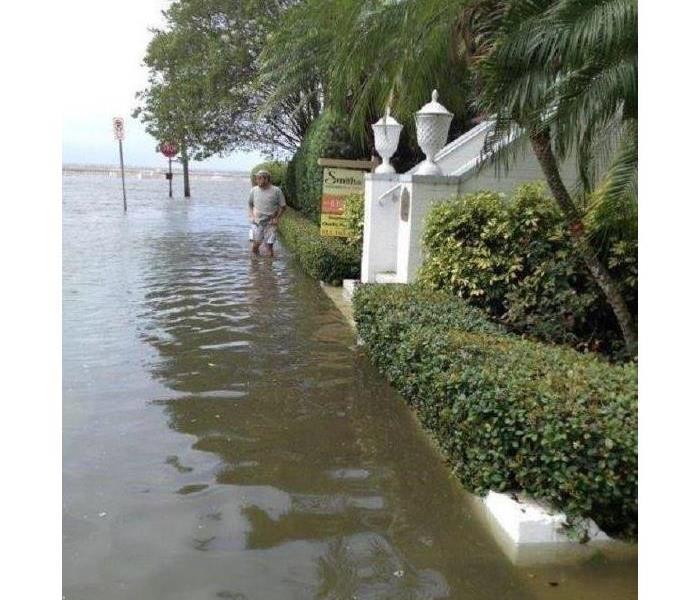 Flooding in South Tampa
Flooding in South Tampa
A flooded home is a devastating event for any homeowner. It has the ability to ruin many of your possessions in addition to your property itself. Due to the fact that water damage can quickly become permanent if not addressed as soon as possible, if you do suffer flood damage to your home, it is important that you call the professionals at SERVPRO of South Tampa to help restore the home. However, there are some things that you can do before they arrive. Here are some things you can do immediately after a flood to start the restoration process.
Call Your Insurance Agent
Regardless of how bad a flood has hit your home; it has likely done some significant damage to some of your possessions and to the structure of your home. Soon after you recognize the damage, you should call your insurance agent. Most water damage in the home is covered by homeowner’s insurance policies but you’ll want to contact them to make sure as there could be exclusions.
Check Before Entering Home
Before you re-enter your home after flood damage, check for any structural damage that may have occurred. Severe flooding or water damage has the ability to compromise the integrity of the structure. If you enter the home without closely inspecting what you’re walking into, the building could potentially collapse, trapping you inside. Once you’ve entered the home, you should be very careful about where you’re walking, especially if you’re moving from carpeting onto a hard surface.
Document Evidence
Once you have entered the home, document the evidence of that damage that has been done by taking photos of it. If there are any questions, particularly by your insurance company about the validity of your claim, you’ll have evidence to show them. While you document the damage, save any items that you can. Some items, such as porous materials, may have been damaged beyond repair. When the SERVPRO crew arrives to restore the home, they’ll save as many items as possible. But if there are items that have not been damaged, you can take them out to avoid any further potential damage.
Take Inventory
While you’re examining the damage that has occurred in your home, make a list of the damage or lost items in the home. Make sure to include the date they were purchased and their value with any receipts you may have. Store that list with any inventory of your possessions that you may have taken before the flood. If any of your possessions must be disposed of, which some may, make sure you have photographs of the items.
Turn Off Power
After the flood damage occurs, turn off all power, especially to the affected rooms. Also refrain from using any electrical appliances as you could electrocute yourself if you’re standing in water. Keep the power to the home off until an electrician can come and thoroughly inspect the system to ensure it’s safe to turn back on again.
Prevent Mold
Mold thrives in environments where moisture is present which makes flooded parts of a house ideal for mold growth. The existence of mold in a home can be hazardous so it’s important to prevent the mold from growing if at all possible. Removing any wet contents from the home as soon as possible will help to prevent such mold growth around the home.
Proper Protection
Regardless of how well you think you can clean up after a flood, you should call the professionals at SERVPRO of South Tampa to ensure that as much of your property is salvaged as possible. But if you do decide to start the cleanup process before they arrive, it’s important that you are properly attired. Wear long sleeves, pants, gloves, and boots when dealing with flood water to ensure your safety.
If you suffer flood damage in your home, you should contact the professionals at SERVPRO of South Tampa to clean up. But if you want to get the process started prior to their arrival, these tips will help you remain safe.
Call SERVPRO of South Tampa at 813-839-6633
Quick Tips from SERVPRO of South Tampa on Preventing Mold Growth
4/4/2022 (Permalink)
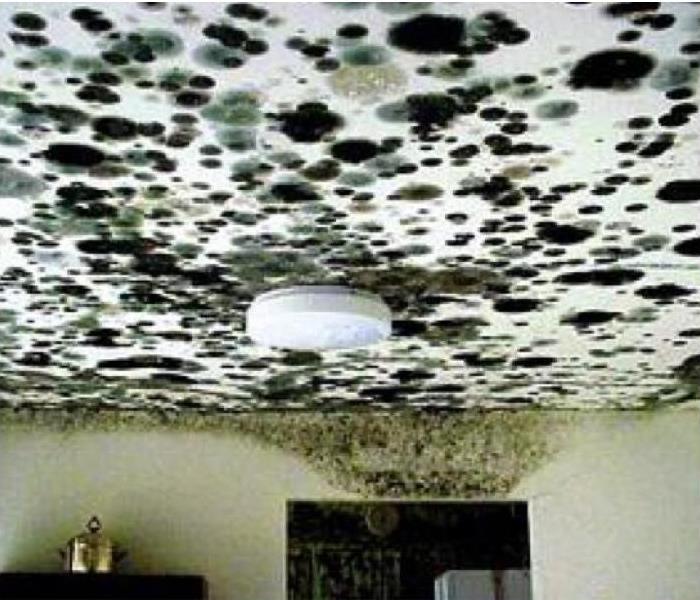 Mold on wet ceiling after Storm Damage
Mold on wet ceiling after Storm Damage
The rainy season is upon us, and with that, the opportunity for mold growth presents itself. Due to this, we recommend that you call SERVPRO of South Tampa at the first signs of any moisture or growth. If you have discovered mold in your Tampa area home or office, we are here to help.
How mold gets into a house or building:
Mold and fungal spores occur naturally outdoors, where fungi are the earth’s most important recyclers. Indoors, mold needs moisture to grow; it becomes a problem only where there is water damage, elevated and prolonged humidity, or dampness. Common sources in the Tampa area of excessive indoor moisture that can lead to mold problems include:
* flooding from surface waters (i.e., overflowing streets) or from severe storms;
* roof leaks from damaged or missing roofing materials, blocked gutters;
* storm-driven rain through window frames, exterior walls or door assemblies;
* leaking pipes, sewer back-ups or overflows;
* damp crawl spaces due to a high water table or poorly managed rainwater drainage; and
* condensation on cold surfaces.
How to prevent mold growth:
The key to preventing and stopping indoor mold growth is to control excessive moisture and condensation. Keeping susceptible areas in the home clean and dry is critical. In general, mold will not grow indoors without water, dampness, or excessive moisture.
Three main factors contribute to condensation of water on building surfaces:
* Relative Humidity: Condensation occurs when the air is saturated with water and it cannot hold any more moisture. For example, steam generated from bathroom showers or from cooking can fill up the air with moisture, which will then condense into drops of water on cooler surfaces, such as mirrors and windows. Where possible, localized sources of humidity, such as clothes dryers, should be directly vented to the outdoors. To lower indoor humidity during warm, humid weather, air conditioners should be used.
* Temperature: Warm air holds more moisture than cold air. Condensation occurs when warm humid air comes into contact with a cold surface and the moisture condenses into water. This can often be seen on single-pane windows, where water condenses and then runs down, causing the wood frames and sills to rot and the wall under the windows to blister.
* Poor Ventilation: Indoor humidity can build up if there is not enough ventilation and exchange of indoor and outdoor air. Where there is little or no air movement, such as behind dressers and cabinets, surfaces can remain cooler than surrounding areas, which can lead to increased condensation and mold growth. It is recommended that the area is ventilated and the occupants use exhaust fans (vented to the outdoors) to remove moisture from high-humidity areas, particularly in bathrooms, kitchens, and laundry areas. Furniture should be moved slightly away from walls so that air can freely pass behind it. Air should be allowed to circulate between rooms and regularly ventilate to remove humid air. Fans should be used as needed.
Other things that can be done are to clean and repair gutters regularly, make sure the ground slopes down and away from the home’s foundation and keep air conditioner drip pans and drain lines clean. In addition, in air-conditioned buildings in hot and humid climates, vinyl wall coverings on the interior sides of exterior walls should not be used, as these materials can trap moisture, resulting in mold growth underneath them.
In the case of floods or leaking pipes, any standing water should be promptly removed and water-damaged materials should either be dried out and cleaned, or removed and replaced. Porous materials that are wet for more than 48 hours are likely to produce mold growth and should be discarded. In instances where the water damage is extensive, it is recommended that you call SERVPRO of South Tampa at (813) 839-6633, so that we may assist you in preventing growth after water damage, or to remove the mold if it is already an issue.
Easy steps to cleaning Gutters after a Storm.
4/4/2022 (Permalink)
SERVPRO of South Tampa knows that we get our fair share of sunny days throughout the year, however it also brings the occasional rainstorm. By dumping a high volume of water in a relatively short amount of time, it’s important to take precautionary measures to prevent building that can affect your drain pipes.
One measure you can take is cleaning out your home’s gutters after a storm hits, and you can do it in three easy steps:
First, start by scooping out debris. Find a ladder and securely place it against your home so you are able to reach the gutters comfortably. Start at the end closest to the drain outlet and gradually working your way to the other end, removing loose debris as you go.
Second, use a hose to spray a steady stream of water through the gutters towards the drain outlet. This will help remove and stubborn dirt and debris that may still be holding on from when you were scooping.
Third, be sure to check your drain pipes for any blockage. In some instances, rainstorms can force material into the pipes, causing potentially severe damage. A good way to detect if your drain pipes are blocked is if you see a trickle of water rather than a flow coming from them. If this is the case, try using a hose at the top of the gutter and spray directly into the outlet to help clear any congestion.
Following these steps will help prevent your gutters from taking on damage from blockage and build up. If you experience any major damage, give SERVPRO of South Tampa a call at (813) 839-6633 and our experts will be there to help you resolve and repair the issue!
When Storms or Floods hit South Tampa, SERVPRO is ready!
6/22/2021 (Permalink)
 Hallway Storm Water Intrusion
Hallway Storm Water Intrusion
SERVPRO ® of South Tampa specializes in storm and flood damage restoration. Our crews are highly trained and we use specialized equipment to restore your property to its’ pre-storm condition.
Faster Response:
Since we are locally owned and operated, we can respond quicker with the right resources, which is extremely important. A fast response lessens the damage, limits further damage, and reduces the restoration cost.
Resources to Handle Floods and Storms:
When storms hit Tampa, we can scale our resources to handle a large storm or flooding disaster. We can access equipment and personnel from a network of 1,650 Franchises across the country and elite Disaster Recovery Teams that are strategically located throughout the United States. See our page at https://www.SERVPROsouthtampafl.com/storm-flooding-restoration
Have Storm or Flood Damage? Call SERVPRO of South Tampa at (813) 839-6633
How to clean your gutters after a storm in Tampa
2/10/2020 (Permalink)
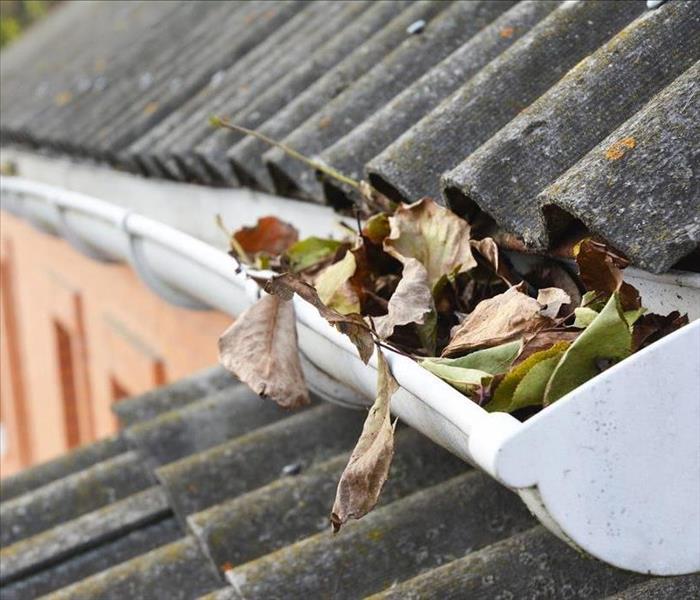 Cleaning home gutters in Tampa
Cleaning home gutters in Tampa
SERVPRO of South Tampa knows that we get our fair share of sunny days throughout the year, however it also brings the occasional rainstorm. By dumping a high volume of water in a relatively short amount of time, it’s important to take precautionary measures to prevent building that can affect your drain pipes.
One measure you can take is cleaning out your home’s gutters after a storm hits, and you can do it in three easy steps:
First, start by scooping out debris.Find a ladder and securely place it against your home so you are able to reach the gutters comfortably. Start at the end closest to the drain outlet and gradually working your way to the other end, removing loose debris as you go.
Second, use a hose to spray a steady stream of water through the gutters towards the drain outlet. This will help remove and stubborn dirt and debris that may still be holding on from when you were scooping.
Third, be sure to check your drain pipes for any blockage. In some instances, rainstorms can force material into the pipes, causing potentially severe damage. A good way to detect if your drain pipes are blocked is if you see a trickle of water rather than a flow coming from them. If this is the case, try using a hose at the top of the gutter and spray directly into the outlet to help clear any congestion.
Following these steps will help prevent your gutters from taking on damage from blockage and build up. If you experience any major damage, give SERVPRO of South Tampa a call at (813) 839-6633 and our experts will be there to help you resolve and repair the issue!
How to prepare your home for Storm damage in Tampa
2/10/2020 (Permalink)
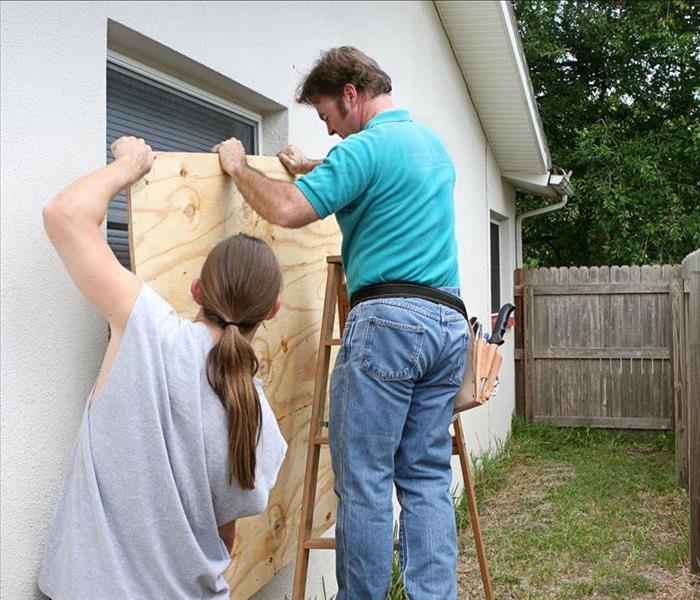 Preparing your home for Storm damage in Tampa
Preparing your home for Storm damage in Tampa
When news stations report the weather today, people tend to pay more attention to what’s being reported. Since Tampa weather can produce many different types of unsettling conditions, it is not uncommon for everyone to expect most anything. It does not matter which areas of the country are impacted by the weather, especially because the most recent storms are causing all kinds of problems and issues of concerns. From large balls of hail hitting windows in the home and causing them to break to flood waters rising because of large volumes of rain coming down for longer periods of time, stormy weather can be very unpredictable.
Preparing Your Home Before a Storm
Getting ready for the storm before it hits is one of the ways for a homeowner to protect the interest that they have in their property. However, sometimes the preparation made will not make any difference if the winds are so strong that they rip off of the roofing on the top of the home. In some cases, the winds will leave Tampa storm damage behind that may cost the owner or their insurance companies tens of thousands of dollars in repairs. So, the aftermath of a storm can be solemn for the owner and their family members.
Recovering After the Storm Passes Through
Typically, after a major storm passes through any area, owners are left with the aftermath to clean up and restore back to its original condition. Based on the severity of the damage that’s left, the owner may need to call a professional storm damage of Tampa recovery team to begin the process of cleaning up. These services are usually needed when the storm causes major damage to the roofing or the waters from the storm floods one or more rooms in the home. When this is the case, owners will need to protect their investment by contacting our team of technicians for emergency services. These services are available 24 hours a day and 7 days a week so we can get started right away devising a plan of action. In fact, we will provide the homeowner and their family members with several key services including cleaning up the excess water, drying the areas impacted in the home, using antibacterial treatments for the family’s safety and restoring the home back to its original condition.
The impact of a storm can be very challenging for homeowners who have had storm damage near Tampa. Even though an owner can start the process of protecting the home before it passes through, they cannot always predict what is going to happen and the damage that it is going to cause. However, after the storm has passed through, the owners can hire our technicians to assist with the clean-up and recovery process.
For those of you who need a professional to visit your home for an assessment of the damage and a plan, you should call SERVPRO of South Tampa at (813) 839-6633 today!
What you need to know to prevent roof leaks from storm damage
2/10/2020 (Permalink)
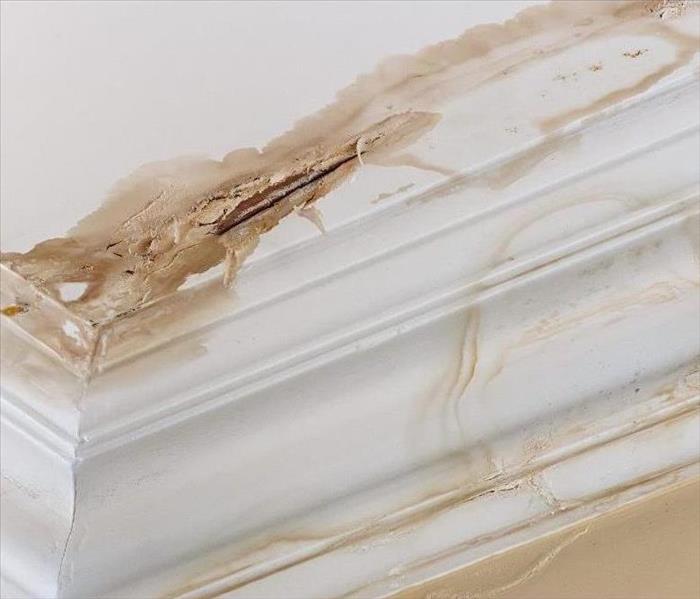 Preventing roof leaks from storm damage in Tampa
Preventing roof leaks from storm damage in Tampa
The first step toward a leak-free roof happens before any storms are on the horizon. Many homeowners are aware of the potential roof damage that can come from a hail storm. However, many residents, FL don’t know how to respond afterward to prevent further flooding and structural issues from affecting the home.
Inspection and Preparation
The first step toward a leak-free roof happens before any storms are on the horizon. Many insurers will insist on regular roof inspections, especially if you have a more expensive policy or property. This sort of preventative maintenance keeps the roof in good shape in case a severe weather event does occur. Sometimes everyday wear and tear is the first sign that a roof will undergo water or wind damage later on.
Finding Points of Interest
Most roofing inspections will involve a number of steps. The layering, position, and condition of the shingles is one of the most important initial markers of a potential roof damage. If any of the asphalt shingles are broken or missing, water will begin to flow toward and under the plastic barrier beneath, given enough time. Re-roofing is fairly inexpensive and can save money in the long run by preventing damage to plywood, insulation, and structural beams in your attic.
Removing Wet and Damaged Materials
Once the roof leak has been identified, it's time to start cleanup and restoration both inside and outside. The area must be cleared of ruined and damp materials. You should remove items from the water's path as much as possible. Cover objects that cannot be moved with plastic to prevent mold and water damage from developing. Contain as much water as you can from your damaged roof with buckets or other large containers. This can be a very big job and many leaks will require professional cleaning and restoration services.
Drying & Disinfecting the Affected Area
Once the area has been cleared of wet materials, it needs to be thoroughly dried out and disinfected. You may be able to dry some items yourself, such as small furnishings and personal items. Keep the area as well-ventilated as you can. Larger storm cleanup projects require pros since they have the proper training, experience, and equipment to handle the situation.
Restoring Roof and Ceilings
After the affected area is dry and clean, the restoration process can begin. Repair needs will depend on the extent of the destruction sustained. Restoration often includes replacing missing shingles, repairing damaged gutters and downspouts, and fixing flashing around vents and chimneys.
Finding a roof leak in your Tampa, building doesn't have to become a headache. Take action as soon as possible to prevent bigger problems. Contact a water damage remediation specialist to manage the situation fast, and you'll be back in business in a snap.
Remember, many roof damage and flood scenarios may require professional intervention from a qualified cleanup company. However, with adequate knowledge and preparation, you can face any inclement weather with confidence.
Give SERVPRO of South Tampa a call at (813) 839-6633 today if you need help to prepare for storm damage!
Dealing with Storm Damage in Tampa
1/14/2020 (Permalink)
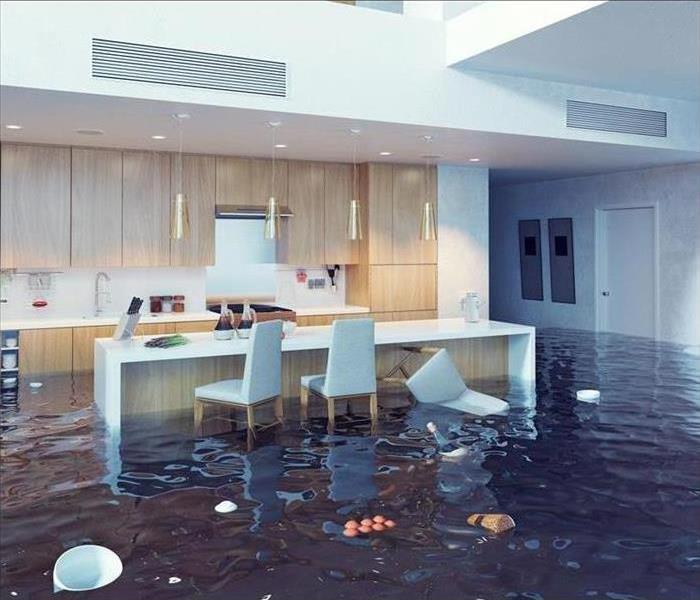 Storm Damage restoration services in Tampa
Storm Damage restoration services in Tampa
In the Tampa area, we're used to preparing for storms. These reminders should help you and your family prepare for the next one that comes our way.
Water Preparation
A traditional standing water heater holds up to 40 gallons of clean water. If the water to your home isn’t flowing this is a amazing last resort. However, if there's water going into the home, make sure you check with county sites to find out if you are under a boil water alert or not. Make sure you have 1 gallon of water per person for up to one week stored before the storm hits.
Food Preparation
Canned food and none perishable foods like beans, canned vegetables, and soups are amazing to have around. If you have a small gas cooking device you’ll want to empty out your freezer as fast as possible of any frozen foods so make sure to cook through your perishable foods before your canned foods.
Gas/Fuel
Make sure you have a full tank of gasoline in all of your vehicles. Fuel might become limited during an emergency situation. So you’ll want to make sure you are topped off before the storm hits. As for fuel oil this goes for gasoline for generators, propane for cooking, and lamp oil if you plan to use gas lamps for a lightning source.
Outside of these basic items there are an assortment of other items you'll want to keep handy such as:
- hand cranking can opener
- First aid kit
- Cooler for perishable foods
- duct tape and garbage bags
- Flashlight and batteries
This short list of items can keep you prepared for the aftermath of an emergency. It’s recommended each year you check off an emergency disaster check-list to insure your stocks are full before a disaster happens.
Give SERVPRO of South Tampa a call when you need help when preparing or dealing with storm damage!
When Storms or Floods hit Tampa, SERVPRO is ready!
10/9/2018 (Permalink)
SERVPRO ® ofSouth Tampa specializes in storm and flood damage restoration. Our crews are highly trained and we use specialized equipment to restore your property to its pre-storm condition.
Faster Response
Since we are locally owned and operated, we are able to respond quicker with the right resources, which is extremely important. A fast response lessens the damage, limits further damage, and reduces the restoration cost.
Resources to Handle Floods and Storms
When storms hit Tampa, we can scale our resources to handle a large storm or flooding disaster. We can access equipment and personnel from a network of 1,650 Franchises across the country and elite Disaster Recovery Teams http://www.SERVPROsouthtampafl.com/commercial-storm-cleanup that are strategically located throughout the United States.
Have Storm or Flood Damage? Call Us Today (813) 839-6633






 24/7 Emergency Service
24/7 Emergency Service





